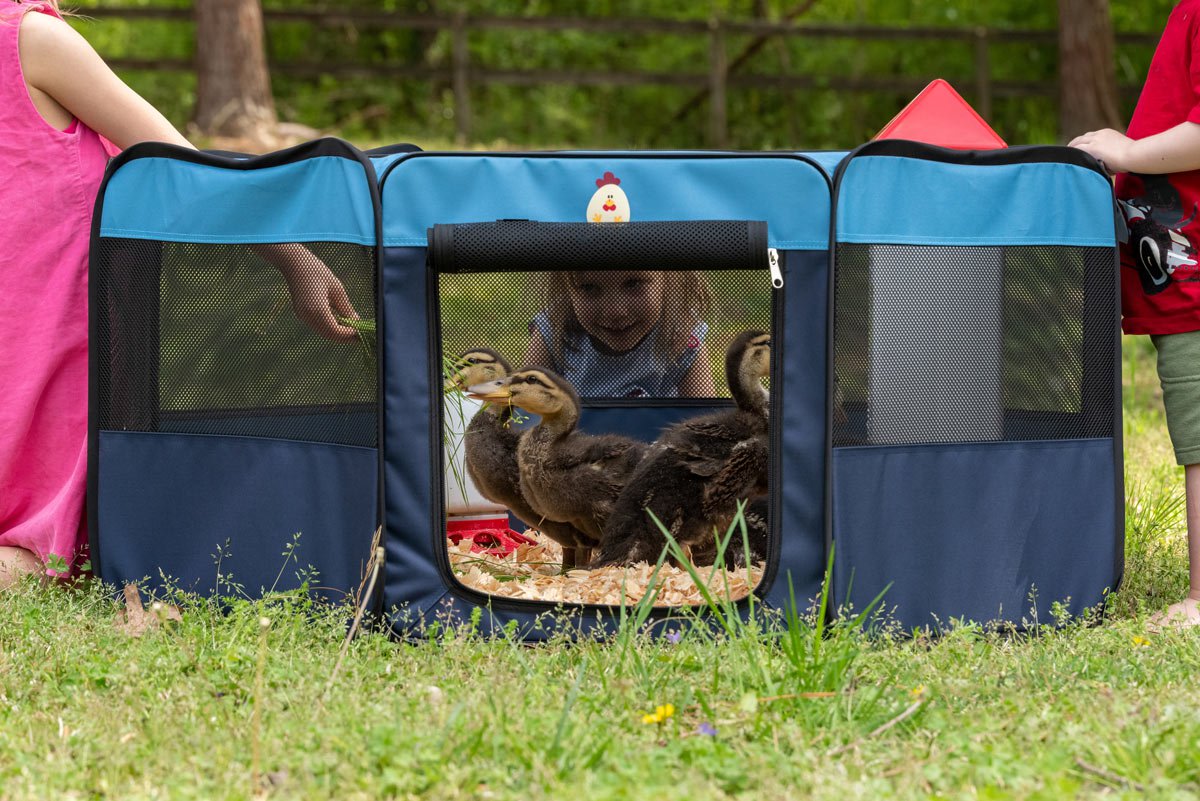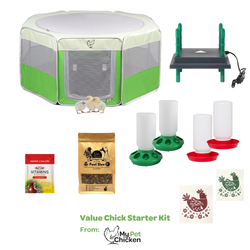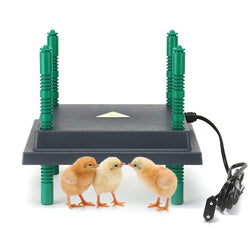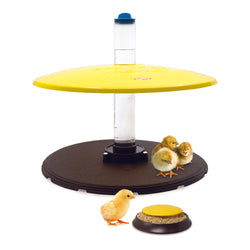How do I care for ducklings and goslings?
Back to blog
Baby ducks and geese are EXTREMELY cute, and they are generally easier to raise than chicks. Nevertheless, if you decide to add geese or ducks to your flock, it is important that you be well-prepared. Those cute little balls of fluff will be depending on you! Here are some tips to help you prepare for your new waterfowl flock:

A simple cardboard box brooder.
Be prepared; waterfowl babies grow quickly! In the brooder and pen, ducklings will need at least 1 square foot per bird their first 3 weeks, 3 square feet from 4-8 weeks of age, 3.5 square feet from 9-17 weeks of age, and 4 square feet thereafter. Bantam breeds will need about half that amount. Goslings will need 1.5 square feet per bird the first 3 weeks, 4.5 square feet during weeks 4-8, 6 square feet when 9-17 weeks of age, and 9 square feet per bird thereafter. Do not overcrowd your birds, as that can cause feather eating and an increased bacterial and parasite load. Because waterfowl can be so messy, you'll want to cover the floor with at least 2 inches of wood shavings or straw for bedding. Make sure that any bedding materials you use have not been treated with chemicals and are mold-free. Do not use slick materials like newspaper, as that can cause spraddle leg (also called "splay" leg), a crippling condition for baby poultry. You can find out how to treat spraddle leg in our spraddle leg overview.
Baby waterfowl need less heat than chicks, and their heat needs will depend on ambient air temperature, humidity, and flow of air. Unlike chicks that you start off at 95 degrees and then lower the temperature five degrees per week, ducklings you start off at 90 degrees and then lower the temperature by five to seven degrees per week when measuring the temperature at the floor under a heat lamp. The outer edges of the brooder should be about 10 degrees F cooler than under the heat lamps. Turn your heater on the day before you expect the birds to arrive so the bedding is warm for them (don't worry, we'll send you a tracking number so you can follow their progress). One heat lamp can handle about 35 ducklings or 20 goslings. But please note: heat lamps are a serious fire risk! If you use a heat lamp, be sure not to place it any closer than 18 inches from the bedding, walls, or any other structures in the brooder. Consider using a safer brooder heater so that what happened to one of our staff members does not happen to you.

Ducklings in a simple plastic bin brooder.
Place your water container in the brooder a day in advance so it is not too cold when the babies arrive. You will need to design your waterer in such a way that the babies cannot get into the water and become soaked, which can lead to chilling. However, they will need enough water to dip their heads under to wash their eyes and bill. One common solution for messy ducklings and goslings is placing their waterer on a screen-covered platform which allows the water to drop down to the bedding, keeping the watering area dry. Another option is putting a scrap piece of 2x4 lumber under the waterer so they can drink but not actually get into the water. Make sure the elevated waterer is steady enough to keep them from knocking it over.

A uniquely-designed duckling waterer.
Ducklings and goslings need more niacin than many commercial chick starter feeds provide, so be on the lookout for niacin deficiency: weak or bowed legs, stunted growth, and enlarged hocks. To prevent niacin deficiency when using regular chick starter feed, add niacin to drinking water at 100-150 mg per gallon from 0-10 weeks of age (niacin tablets or powder can be found at drug stores). Be aware that most plant-based niacin is not available for waterfowl to metabolize, but once your young waterfowl are able to forage and eat insects, they will usually get plenty of niacin naturally.
Supplemental niacin may not be required if you are using duck starter feed rather than chick starter feed. You will not see "niacin" listed in the guaranteed analysis on the feed bag, so we recommend that you contact the manufacturer of your feed to make sure that it includes enough niacin for baby waterfowl.
You'll want to provide grit--coarse sand or chick-sized granite--when the birds begin to eat anything but chick feed. Grit is used by their crop to help them digest food. Do not use oyster shell as grit, as the goslings and ducklings can overdose on calcium. More information about grit.
When to switch from starter to grower feed:

Kids can help care for ducklings and goslings!
Many customers worry about whether their babies are warm enough--or too warm! Thankfully, it's easy to tell. The best way to judge the comfort of the birds is to watch them. If they are all huddled under the heater, they need more heat. If they are all bedded down away from the heater or breathing with their mouths open (panting), the heat source is too low or it is too warm in the room. Comfortable birds should be spread throughout the brooder with some eating, some drinking, some sleeping, and some playing.
If you ordered your birds from My Pet Chicken and they were sexed, they will be distinguished by colored rubber bands. If the band is on the bird's right leg it is a male; if it is on the bird's left leg, it is a female. As these are rubber bands, they are extremely easy to remove. Just gently hold the band and roll it down over the foot. We recommend that you remove the bands within the bird's first week.
How will I know which breeds are which on my waterfowl order?
Typically the temperature in the brooder can be dropped about five degrees per week and turned off during the day by 2-3 weeks of age. You will likely be able to turn the heat off completely by 3-5 weeks in cooler weather. If you are raising them in a warm climate, they may not need extra heat after a week or two. Their behavior will let you know whether they need more or less heat. As they grow and add weight you can allow them to venture outdoors for brief periods during the day. Once they are fully feathered (6-8 weeks) they can stay outside all the time, but they should still have some shelter from the sun and heavy rains.

Baby ducks will turn anything into a swimming pool!
Again, waterfowl can be very messy with their water! To save yourself some trouble, it is best to make a wire platform on which the waterer sits. For babies, use 1/2" hardware cloth or screen, and for adults, you can use 1" welded wire nailed to wooden cross pieces. This can be placed over a pan for the babies or over a pit in the ground for the adults. The platform should be large enough to extend at least 6" out from the edge of the waterer for the babies and 30" for the adults. With this platform, any spilled water goes through the wire and out of reach. They cannot track it back to the bedding or make a mud puddle with it. Their drinking water stays cleaner, too. You may also want to try nipple waterers, which are much less messy than traditional waterers.
Ducklings and gosling absolutely LOVE getting into their water to swim and splash around, and it is a good idea to provide water deep enough for them to dip their heads into to clean their eyes and nostrils, but it is not essential for them to have deep water for swimming.
Do ducks and geese have to have swimming water?
However, for hours of entertainment--and for their enjoyment!--you may want to provide your birds with swimming water periodically. Ducklings and goslings can be introduced to swimming water as early as two weeks of age, but you need to be very careful when doing so. They must be able to walk in and out of the water very easily. The water should not be too cold, and they have to be able to find their heated area for rewarming without difficulty. As they have no oil on their feathers at this age, they cannot be in the water for long periods or they will become waterlogged and chilled--and even drown. Do not allow this to happen! Even with the risks, exposing them to water is a good idea, as it speeds the development of their oil gland. Just do it carefully! With your oversight, they will probably be swimming freely by five or six weeks of age.
Can ducks and geese be outside during the winter?

When grown, ducks and geese are generally more hardy than chickens in cold, wet weather.
Unless you are absolutely certain there are no predators in your neighborhood (this is very rare) you must put your birds in a predator-proof pen, with a roof, at night. Chickens will automatically come home to roost, and waterfowl can be trained - especially if they are given a treat when they come in each evening. Make it a habit and your birds will be much safer.

A mobile poultry tractor provides protection and access to fresh forage as it is moved around the yard.
You made it! Your waterfowl flock has graduated to the outdoors and are accustomed to their shelter as "home." You can expect to enjoy many years of fun watching their antics and taking advantage of the other benefits that come from keeping ducks and geese!
Before they arrive
You are going to need a "brooder," which is just a designated place that provides the protection, feed, water, and warm environment they need their first few weeks of life. A brooder can be just a simple plastic bin or cardboard box, or something much more elaborate that you make or repurpose yourself. It can be located inside the house or in a barn, outbuilding, or garage, as long as the area is protected from drafts, predators (including dogs, cats, and rodents), and sudden temperature fluctuations. If the brooder area has housed poultry before, you'll want to clean and disinfect it to avoid the potential spread of disease. Cornell University provides some great tips for cleaning and disinfecting your coop.
A simple cardboard box brooder.
Be prepared; waterfowl babies grow quickly! In the brooder and pen, ducklings will need at least 1 square foot per bird their first 3 weeks, 3 square feet from 4-8 weeks of age, 3.5 square feet from 9-17 weeks of age, and 4 square feet thereafter. Bantam breeds will need about half that amount. Goslings will need 1.5 square feet per bird the first 3 weeks, 4.5 square feet during weeks 4-8, 6 square feet when 9-17 weeks of age, and 9 square feet per bird thereafter. Do not overcrowd your birds, as that can cause feather eating and an increased bacterial and parasite load. Because waterfowl can be so messy, you'll want to cover the floor with at least 2 inches of wood shavings or straw for bedding. Make sure that any bedding materials you use have not been treated with chemicals and are mold-free. Do not use slick materials like newspaper, as that can cause spraddle leg (also called "splay" leg), a crippling condition for baby poultry. You can find out how to treat spraddle leg in our spraddle leg overview.
Baby waterfowl need less heat than chicks, and their heat needs will depend on ambient air temperature, humidity, and flow of air. Unlike chicks that you start off at 95 degrees and then lower the temperature five degrees per week, ducklings you start off at 90 degrees and then lower the temperature by five to seven degrees per week when measuring the temperature at the floor under a heat lamp. The outer edges of the brooder should be about 10 degrees F cooler than under the heat lamps. Turn your heater on the day before you expect the birds to arrive so the bedding is warm for them (don't worry, we'll send you a tracking number so you can follow their progress). One heat lamp can handle about 35 ducklings or 20 goslings. But please note: heat lamps are a serious fire risk! If you use a heat lamp, be sure not to place it any closer than 18 inches from the bedding, walls, or any other structures in the brooder. Consider using a safer brooder heater so that what happened to one of our staff members does not happen to you.

Ducklings in a simple plastic bin brooder.
Place your water container in the brooder a day in advance so it is not too cold when the babies arrive. You will need to design your waterer in such a way that the babies cannot get into the water and become soaked, which can lead to chilling. However, they will need enough water to dip their heads under to wash their eyes and bill. One common solution for messy ducklings and goslings is placing their waterer on a screen-covered platform which allows the water to drop down to the bedding, keeping the watering area dry. Another option is putting a scrap piece of 2x4 lumber under the waterer so they can drink but not actually get into the water. Make sure the elevated waterer is steady enough to keep them from knocking it over.

A uniquely-designed duckling waterer.
Feeding baby ducks and geese
Generally speaking, baby ducks and geese can be given non-medicated commercially-produced chick starter feed crumbles. Starter crumbles are preferred over powder, as ducklings and goslings can choke on powdery feeds. Waterfowl should not be given medicated feed that is not formulated specifically for them.Ducklings and goslings need more niacin than many commercial chick starter feeds provide, so be on the lookout for niacin deficiency: weak or bowed legs, stunted growth, and enlarged hocks. To prevent niacin deficiency when using regular chick starter feed, add niacin to drinking water at 100-150 mg per gallon from 0-10 weeks of age (niacin tablets or powder can be found at drug stores). Be aware that most plant-based niacin is not available for waterfowl to metabolize, but once your young waterfowl are able to forage and eat insects, they will usually get plenty of niacin naturally.
Supplemental niacin may not be required if you are using duck starter feed rather than chick starter feed. You will not see "niacin" listed in the guaranteed analysis on the feed bag, so we recommend that you contact the manufacturer of your feed to make sure that it includes enough niacin for baby waterfowl.
You'll want to provide grit--coarse sand or chick-sized granite--when the birds begin to eat anything but chick feed. Grit is used by their crop to help them digest food. Do not use oyster shell as grit, as the goslings and ducklings can overdose on calcium. More information about grit.
When to switch from starter to grower feed:
- From 0-2 weeks, give them finely-milled or crumble chick starter feed.
- From 3 weeks until they produce their first egg, offer them grower crumble. Do not switch to layer pellets too early, as it can provide too much calcium for non-laying juveniles.
- While they are producing eggs, give them layer pellets.
- Between laying seasons, if available, you can switch to pelletized maintenance feed. Otherwise, you can keep them on layer pellets.
They've arrived!
Normally the post office will call you when your birds arrive and ask you to pick them up. When you get them home, dip the bill of each bird in water, as it is the most important nutrient they need at this time. Make sure they tip their head back to drink. If they have had a rough journey and seem weak, we recommend you|add a cup of sugar to each quart of their drinking water and check them every 30-60 minutes to give them another drink. If you do have a few that are weaker than the others, it is best to separate them until they regain their strength. Make sure that any separated birds have access to necessary heat, water, and feed. If they look sleepy with squinty eyes, this means they are dehydrated and they will only survive if you ensure they drink several times within the first two hours.
Kids can help care for ducklings and goslings!
Many customers worry about whether their babies are warm enough--or too warm! Thankfully, it's easy to tell. The best way to judge the comfort of the birds is to watch them. If they are all huddled under the heater, they need more heat. If they are all bedded down away from the heater or breathing with their mouths open (panting), the heat source is too low or it is too warm in the room. Comfortable birds should be spread throughout the brooder with some eating, some drinking, some sleeping, and some playing.
If you ordered your birds from My Pet Chicken and they were sexed, they will be distinguished by colored rubber bands. If the band is on the bird's right leg it is a male; if it is on the bird's left leg, it is a female. As these are rubber bands, they are extremely easy to remove. Just gently hold the band and roll it down over the foot. We recommend that you remove the bands within the bird's first week.
How will I know which breeds are which on my waterfowl order?
As they grow...
Poultry (and especially waterfowl) grow very quickly. Make sure you enlarge their pen as needed and add clean bedding as necessary. Typically it is better to add clean bedding on top of the old bedding instead of removing the soiled bedding every day. You can clean it all out once the birds are moved to a new pen. The bedding can be removed from their permanent pen every few months or as needed.Typically the temperature in the brooder can be dropped about five degrees per week and turned off during the day by 2-3 weeks of age. You will likely be able to turn the heat off completely by 3-5 weeks in cooler weather. If you are raising them in a warm climate, they may not need extra heat after a week or two. Their behavior will let you know whether they need more or less heat. As they grow and add weight you can allow them to venture outdoors for brief periods during the day. Once they are fully feathered (6-8 weeks) they can stay outside all the time, but they should still have some shelter from the sun and heavy rains.

Baby ducks will turn anything into a swimming pool!
Again, waterfowl can be very messy with their water! To save yourself some trouble, it is best to make a wire platform on which the waterer sits. For babies, use 1/2" hardware cloth or screen, and for adults, you can use 1" welded wire nailed to wooden cross pieces. This can be placed over a pan for the babies or over a pit in the ground for the adults. The platform should be large enough to extend at least 6" out from the edge of the waterer for the babies and 30" for the adults. With this platform, any spilled water goes through the wire and out of reach. They cannot track it back to the bedding or make a mud puddle with it. Their drinking water stays cleaner, too. You may also want to try nipple waterers, which are much less messy than traditional waterers.
Ducklings and gosling absolutely LOVE getting into their water to swim and splash around, and it is a good idea to provide water deep enough for them to dip their heads into to clean their eyes and nostrils, but it is not essential for them to have deep water for swimming.
Do ducks and geese have to have swimming water?
However, for hours of entertainment--and for their enjoyment!--you may want to provide your birds with swimming water periodically. Ducklings and goslings can be introduced to swimming water as early as two weeks of age, but you need to be very careful when doing so. They must be able to walk in and out of the water very easily. The water should not be too cold, and they have to be able to find their heated area for rewarming without difficulty. As they have no oil on their feathers at this age, they cannot be in the water for long periods or they will become waterlogged and chilled--and even drown. Do not allow this to happen! Even with the risks, exposing them to water is a good idea, as it speeds the development of their oil gland. Just do it carefully! With your oversight, they will probably be swimming freely by five or six weeks of age.
Time to go outside!
Once they are six to eight weeks old and fully feathered, they can handle temperatures down to 50 degrees Fahrenheit or lower, but must be protected from drastic, rapid temperature changes.Can ducks and geese be outside during the winter?

When grown, ducks and geese are generally more hardy than chickens in cold, wet weather.
Unless you are absolutely certain there are no predators in your neighborhood (this is very rare) you must put your birds in a predator-proof pen, with a roof, at night. Chickens will automatically come home to roost, and waterfowl can be trained - especially if they are given a treat when they come in each evening. Make it a habit and your birds will be much safer.

A mobile poultry tractor provides protection and access to fresh forage as it is moved around the yard.
You made it! Your waterfowl flock has graduated to the outdoors and are accustomed to their shelter as "home." You can expect to enjoy many years of fun watching their antics and taking advantage of the other benefits that come from keeping ducks and geese!



